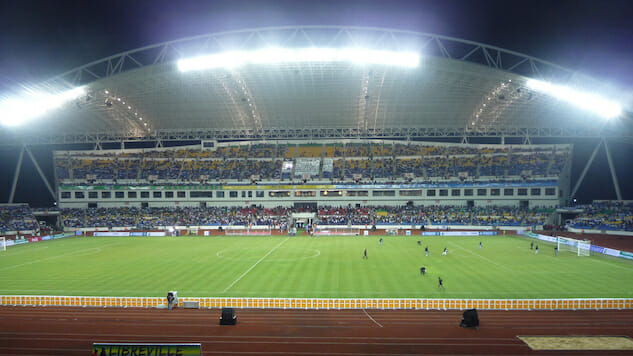Why the Most Influential Country at the Africa Cup of Nations Isn’t in Africa

Starting this Saturday, national teams from all across the continent will take to the pitch in Gabon for the 2017 African Cup of Nations. The tournament will be a source of national pride for the hosts, particularly if their underdog squad surpasses expectations. However, AFCON 2017 is meant to serve another nation’s power and influence, one outside the African continent: China.
Three of the four stadiums that will host matches over the next month were in effect “gifts” from the Chinese government to the people of Gabon. One, which opened in the capital of Libreville in 2011 and was built by the Shanghai Construction Group, is even nicknamed the “Stade de l’Amitié,” a sign of Sino-Gabonese friendship. These are concrete examples of a brand of soft diplomacy which has given China a unique role in the beautiful game in Africa.
While the Chinese Super League has made headlines in the last year as its clubs used astronomical salaries to poach European stars—or even referees—Chinese “Stadium Diplomacy” is nothing new to other parts of the world. Some of these projects were supported by concessionary loans, some were constructed by state-run entities like the Shanghai Construction Group, and others were paid for by a foreign aid grant from the Chinese government. However, all of these projects are part of a concerted diplomatic effort that started in the latter half of the Twentieth Century and is still going strong.
They crop up all over the place. Costa Rica’s national team, the highest-ranked member of CONCACAF, has played since 2011 in a 35,000-seat stadium for which China footed the entirety of the $100 million bill. A Chinese company recently renovated the Kenyan national team’s home, Moi Internatoinal Sports Centre, which China paid to build in 1987. Myanmar’s national stadium was built by Chinese money in 1985.
Given that altruism is rarely a motivator in international diplomacy, it should come as no surprise that China often earns a return on their investment. When Grenada needed aid after a devastating hurricane in 2004, for instance, it agreed to accept a generous aid package from Taiwan. When the People’s Republic came in with a better offer, however, Grenada’s Prime Minister reneged on the deal with the Taiwanese. Relations between the two island nations broke down, and China gained one more ally in its fight against the international recognition of Taiwan. Two years later, a cricket stadium built with Chinese labor and money opened in the capital of St. George’s.
-

-

-

-

-

-

-

-

-

-

-

-

-

-

-

-

-

-

-

-

-

-

-

-

-

-

-

-

-

-

-

-

-

-

-

-

-

-

-

-








































